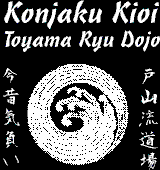|
Home
Hataya
Sensei DVD
Search
Bushido
Respect for Katana
Sword Dictionary
How to Guides
Bow In Ceremony
Warm Up Exercises
Bow Out Ceremony
Wearing Uniform
Formal Uniform
Wearing Daisho
Uniform Folding/Care
Katana Selection
Sword Dimensions
Sword Testing
Katana Maintenance
Katana Cleaning
Mekugi Replacement
Katana Disassembly
Is my sword sharp?
Edge Geometry
Surface Polish
Sharpening Guide
Training Basics
Kihon (Fundamentals)
8 Basic Cuts
Toyama Kata
Toyama Kukmitachi
Seitei Kata
Taikai Guides
Taikai Rules
Judging Guide
Tameshigiri
Target Prep & Spiking
Cutting Patters
Cutting Videos
Target Comparison
St Petersburg Dojo
Intro Letter
Femal Sensei
Dojo Members
Code of Conduct
Classes and Fees
Promotion Pictues
Rank Testing
Links

|
Fundamentals (Kihon) 基本
The katana should be drawn with a consistent and smooth motion
while stepping into a guard stance. The drawing the sword (Battō)
should be a fluid motion that will allow it's immediate use.
The standard guard stance (Seigan) is a versatile position suitable
for both attack and defense.
- Push the katana out with the left thumb
- Do not let the fingers of the right hand go too far around
the tsuka
- Make sure you can clear obi
- Make sure you perform sayabiki (drawing saya from sword)
- Kissaki should go up and forward in a cutting arch after
leaving saya
- Left hand should meet the katana as it reaches Seigan (guard
position)
- Kissaki should be level with throat (pointed towards
opponents eyes)
- Hands should be still and not adjusting grip after reaching
seigon
Proper grip is essential for good swordsmanship. Toyama Ryu
uses a very strong grip that keeps control of the katana even when
doing tameshigiri (test cutting) of hard targets. The student
should strive to get a proper grip every time the katana is drawn.
- Right hand should touch tsuba
- Left hand should be even with kashira (end-cap)
- Last two fingers on left hand should straddle the knot in
the tsuka ito (handle wrap).
- The two bones in the wrist should be parallel to the tsuka
and pointing towards the top of the tsuka
- Pinch with the thumbs and grip with the fingers
- Longer handles are easier to control – but harder to use,
especially if you carry a wakizashi
- Handle size should be – 1/3 of sword from habaki
Stance (Iaigoshi) 居合い腰
A solid low stance is important to stability. If the stance
is too low, it is not mobile enough. If the stance is too high
it becomes unstable. Every step should end in the proper
stance.
- Feet shoulder width apart
- Step forward with right foot and backwards with left foot to
keep position
- Keep the front and back feet about one foot (your foot)
apart
- Flat straight back
- Stomach not out (do not arch back)
- Keep the shoulders down and back
- Balance on toes
- 70% of weight on forward leg
- Forward knee bent until toes not visible
- Rear leg straight but not locked
- Heal not locked on floor
- Heals not pointed in (feet pointed forward)
|

